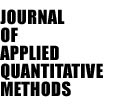 |
|
|||
JAQM Volume 18, Issue 1-4 - December 30, 2023
Contents
Modelling Financial Well-Being: A Multinomial Logistic Model to Uncover Policy Implications and Effective Communication for Enhancing Financial Literacy
Cecilia CIOCIRLAN, Cosmin PROSCANU, Miruna PROȘCANU
Financial well-being (FWB) is generally described as a state of financial stability that enables individuals to feel secure and free from financial stress. A strong financial foundation allows people to meet their financial obligations while making decisions that enhance their quality of life. This study explores the impact of financial literacy and investment choices on FWB. By categorizing financial literacy into different levels of complexity, we found that basic financial knowledge does not significantly affect FWB, while moderate and advanced literacy levels help reduce financial insecurity. The data shows a clear pattern: as financial literacy improves, so does financial well-being. Additionally, most financial assets contribute positively to FWB, particularly savings deposits and cash savings. These findings suggest that financial education programs should be structured progressively, with a focus on achieving at least an intermediate level of literacy. Policy design and communication strategies for financial education should be tailored to specific behavioral traits and delivered through a progressively challenging curriculum.
A computational analysis to predict BMI via intelligent techniques
Nora KORDIC, Giacomo DI TOLLO
The Body Mass Index (BMI) is widely recognized as a key indicator of an individual’s overall health. This contribution presents a computational approach to predict BMI using both traditional statistical methods and Artificial Intelligence techniques, namely Linear Regression, Random Forest, Decision Trees, and Neural Networks. The dataset is composed of health metrics from a sample of women in Belgium collected between 2000 and 2001. This contribution compares the predictive performance of the afore mentioned models and discusses the significance of different health-related indicators on BMI. The results demonstrate the effectiveness of both linear and AI-based approaches in predicting BMI, and provide valuable insights for researchers and practitioners interested in the quantitative assessment of health metrics and disease prediction.
Assessing Age Diversity in Municipal Departments: New Count-Based Indices of Diversity
Salomon Alcocer GUAJARDO
Peculiarities of Design Thinking Implementation on Romanian Courier Industry from an Dynamic Managerial Capability PerspectiveThis article proposed two new count-based indices of diversity to assess qualitative demographic (or social) heterogeneity in public organizations: and . The construct validity and reliability assessments focused exclusively on the unstandardized and standardized scores for age diversity obtained by Δ. The assessments indicated that Δ assesses the same dimension of age diversity as the Gleason, Margalef, Menhinick, and Simpson indices. Additionally, the analyses indicated that Δ possesses the same degree of discriminatory power to detect subtle differences in age diversity as the count- and logarithm-based indices. When the unstandardized and standardized Δ scores were regressed on twelve organizational-based predictors, the ordinary least squares (OLS) regression analysis found more significant statistical relationships amongst the predictors and the Δ scores than the analyses performed on unstandardized and standardized Simpson scores. The OLS regression models for the Δ scores accounted for 45% and 50% of the explained variance, while the models for the Simpson scores accounted for 40% of the explained variance.
Alina MATEI
Demographic Trends and Population Aging in Romania (1977–2011): A Quantitative Analysis of Census DataIn this paper we examine the mechanisms underlying the development of dynamic managerial capability through design thinking. Using a sample of 21 lower-level managers from Romanian courier industry show that there is no statistically significant direct relationship between design thinking training and the improvement in dynamic managerial capabilities. Instead, this relationship is fully mediated by changes in genuine individual-efficacy/ genuine problem solving, latter having a stronger effect.
Andreea-Elena VOROVENCI, Dan DRAGOMIRESCU
This paper analyzes demographic trends and population aging in Romania between 1977 and 2011, using harmonized census microdata from IPUMS International. The results reveal a sustained process of demographic aging, driven by declining fertility, increased life expectancy, and international migration. Key indicators—including age structure, median and mean age, aging index, and fertility levels—demonstrate significant shifts in Romania’s demographic profile. Rural and peripheral areas are particularly affected by population decline and accelerated aging, while urban centers exhibit growing demographic concentration. Additionally, disparities among vulnerable groups such as the Roma population, and mismatches in elderly care infrastructure, highlight the social dimensions of demographic change. The findings underscore the urgency of policy responses aimed at mitigating regional inequalities, supporting intergenerational solidarity, and ensuring the sustainability of social protection systems in the face of long-term demographic decline.

